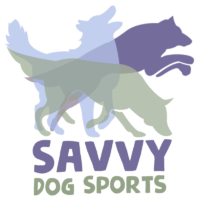In the sport of Nosework, I’ve been noticing more and more dogs finding and then leaving odor. There can be many reasons for this, some more obvious than others.
One reason a dog may leave source is picking up another scent cone if multiple hides are placed in the area. Often a dog will leave a hide (catalog it) to go source another one and then return to the initial one they found.
Others want to check out the whole area before settling into the job … basically wasted energy that only the dog can realize is delaying reinforcement. This should work itself out with more experience.
Confidence is another issue that may cause a dog to leave source … being unsure of what really pays or distracted by the environment which overrides any value for odor.
Another reason is lack of value for odor. The name of this game is value for odor! Odor must be extremely high value for your dog. I know this isn’t sexy, but returning to foundation training is essential for sustained success in Nosework. Often I find people do not pay enough and start to scrimp on the treats! This is no time to be greedy! The find needs to be worth their while by feeding/rewarding a lot at source. I’m talking 30 seconds to a minute of feeding one piece at a time. I would rather do less searches and feed more than run more searches and feed less. As I often say to my students, savor that time rewarding your dog. Be a part of the feeding process and don’t be in a hurry to back off or move on! This will also increase duration at source which is incompatible with leaving!
Do you run too many blind hides where there are missed opportunities to mark/reward? Do you wait too long to acknowledge their indication/change in behavior at source? Are you too set in wanting a specific indication? Unless you are specifically training a trained alert, a dog will naturally have a few ways to tell you they are at source. Know all those indications and be as clear to your dog that you acknowledge their find as they are with you in their behavior. If your dog has a history of leaving source, do not run blind hides so you can make sure to acknowledge and reward your dog for finding odor.
But I think the biggest issue is the rush and frequency to work multiple hides. When there are multiple hides in the search area, especially if placed close together, dogs may end up returning to an already found hide. It’s common practice to not reward again (but praise) so that your dog learns to continue searching for more hides. I cringe every time I see a dog return to a hide that will not pay. We need to manage their search pattern so that they do NOT return to already found hides especially early in their learning with multiple hides. I want to clarify that if we reward at hides they already found, we aren’t teaching them to continue searching for new hides. Since we ARE playing a sport that is timed with rules that allow close hide placements, we must work within that framework to succeed and be smart about our training, setup and handling. Our dogs must learn to move on to find new hides and not be reinforced for going back to found hides.
The key is managing the environment and where you give access to your dog to search. If I can influence it, I want my dog to get paid EVERY time at source so it’s my job when training to prevent access to a hide that has already paid. You can block access, control access to areas using your leash or verbal direction or setup your hide placements to be less likely to return to a found hide (hides far enough apart with a barrier or enough distance for the dog to work each scent cone). You can also decide not to run your dog in searches above their ability or not conducive to their progress.
Keep in mind that even at the NW2/3 titling levels in NACSW, many searches have 1 hide and if multiple hides, they are thoughtfully placed far enough apart so as not to have too much odor convergence. Except for containers, I don’t recall my dog ever returning to or needing to search again near a found hide when trialing in either NW2 or NW3. Until you get to Elite level training, you don’t need hides to be super close together. Set that up as an occasional challenge, but not something you should do often.
What happens when a dog goes back to found hides and doesn’t get paid? They learn that odor doesn’t always pay. How is a dog supposed to know that “this” time they will get paid but this “other” time they will not? Some dogs REALLY do figure out that once found, it won’t pay again and they won’t even go near it or indicate it again. If your dog has not acquired this skill yet, you risk adding confusion where a dog leaves source and then is a lot harder to read. So the key again, it to prevent your dog from going back to found hides. What if your dog shows some indication at source, leaves and you take them back hoping for a stronger alert? This is often a tactic when trialing. Do they really know they were not paid the first time and will now get paid the second time so will more strongly alert? Or will they not indicate again because they know they already found it? Do you see how this can be confusing to your dog?
Working multiple hides is sexy stuff! And you will need that skill in competition – especially in some new organization with games having up to 10 hides in a search area (one is called LudicrouSpeed!). But you don’t need to make this a common search setup and you should make it your top priority to prevent them from returning to a found hide. Think of all the single hide placement challenges you could set up!! You’ll be building value for odor and increasing your dog’s confidence that they can source odor without all the challenges.
As your dog gains more experience and confidence and consistently proves to have high value for odor in novel locations then you can give them more access to your multiple placed hide search areas and work through your dog continuing to find new hides. If you let your dog return to found hides too early in their training – paying or not paying, you could be putting your training in jeopardy!

Even though I don’t have a dog, reading this is very fascinating!
There are as many opinions in managing returning to source and I can say its becoming an issue with my dog who has (1) NW3. Much of the information on “why” makes sense to me and I am guilty as charged. Especially placing too many hides, searching with close converging odors and basically challenges beyond her trial level. I am going to take your suggestion on scaling back the number of hides and complexity. I am very generous in rewarding 1 piece at a time at source but sure it does not take me 30 seconds and can see how duration at source is important. Thank you again for sharing this information!
Hi Judy – here’s an older video showing how long I fed at source for this find. What I tend to do now is stay in closer and just feed, feed, feed, feed, feed, feed (rapid feeding). In this video I was doing a little proofing … and look how great she stayed nose on at source :)! It does build duration at source as that is where they get reinforced!
https://www.youtube.com/watch?v=vq3qT1gv1o0
I’m guilty of rushing. My initial training emphasized immediate feeding but one or two treats was sufficient. It took me a while to understand high value. After reading your article, I’ll cut up more hot dogs.
I updated this blog to clarify that I was not advocating to reward again at found hides, but instead to manage the search (and be smart about hide placements) to minimize them returning to an already found hide. It’s important that early in their career dogs should not return to found hides that do not pay – so the key is to prevent this situation from happening. Once a hide is found, your dog does not need to search that general area again. Remember, 99% of the time we are training – so we can be smart about how these situations are handled.